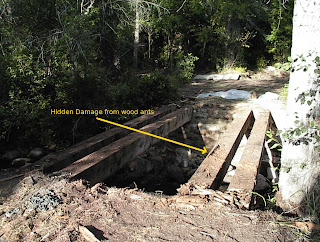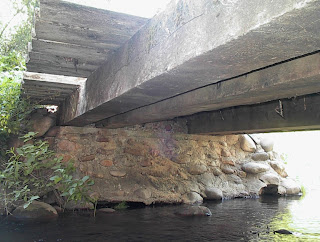
Now that we have the foundation upgraded - And by the way, thank goodness that I was able to upgrade the original foundation since starting over would have been an even bigger job than what was undertaken.
So, the next step is to remove the top deck from the wooden members that comprise the structural component of the bridge - The 12" x 10" x 20' timbers that the top deck is attached to.
You can see from the picture that the top deck is very weathered. The breaks on the sides are from weathering and finally rotting until they break through and the ends fall off. Not a pretty site especially if you were walking along the side. You can also see the plywood patch in the center which covers a broken deck piece that left a hole! What appears to have been happening is that the top runners that the tires drive on hold water between them and the top deck pieces.

After 25 years or so of holding water between the pieces, ants, and probably bacteria, mold etc. have taken their toll. The deck pieces rot out and the ends and center falls out. The option only to replace the top deck ignores the posibility that the structural members have also rotted and may fail due to unseen problems. One of the members had obviously been attacked by wood ants - Big black ants that burough into the wood and build nests. Not what you want in a structural member!

In order to replace the rotting deck top and for safety, the structural members need to be replaced. My brother-in-law works for a construction company that had left over steel structural members from a retaining wall. These twin "C" channel galvanized members were used to replace the wooden beams that were to be removed. The advantage of using galvanized steel is obvious that during what I expect is the rest of my lifetime, the bridge will remain viable and is not expected to rust or be attacked by ants!!
I found a place under the top deck where the wood ants had burrowed into the wood and had hollowed out a nest. This type of damage is not visible unless the top deck is removed. Once removed, it was obvous that the wooden members had to be replaced. As you can see from the picture above, moss is growing on the side of the structural wood members - A hint of what was to be found under the deck.

So, the wooden members across the river were removed and the "C" channels were loaded across the wooden beams after the top deck was removed. You can see the exposed wooden beams in the picture.
Once the top deck was removed, the beams shown below were moved one by one across the wooden beams. Unfortunately, no help moving the beams was available so I used a couple one inch by two foot pieces of pipes to roll the steel members across the wooden beams.
This technique worked incredibly well. One at a time the beams were moved across the wooden beams until two of them were across the river. Once two were on top of the wooden beams, two wooden beams were removed.
 So, before removing the beams, the ends need to be dug up, and a wedge needs to be placed under the end so that they can be pulled out with a chain and a Jeep Cherokee (preferably champagn color).
So, before removing the beams, the ends need to be dug up, and a wedge needs to be placed under the end so that they can be pulled out with a chain and a Jeep Cherokee (preferably champagn color).Take a look at the next pictures showing the removal of the old timbers.

You can see the beams on top of the two timbers and one of the timbers about to be removed. Here is a better shot of how the timbers were pulled from the foundation. Until next time; be good.








